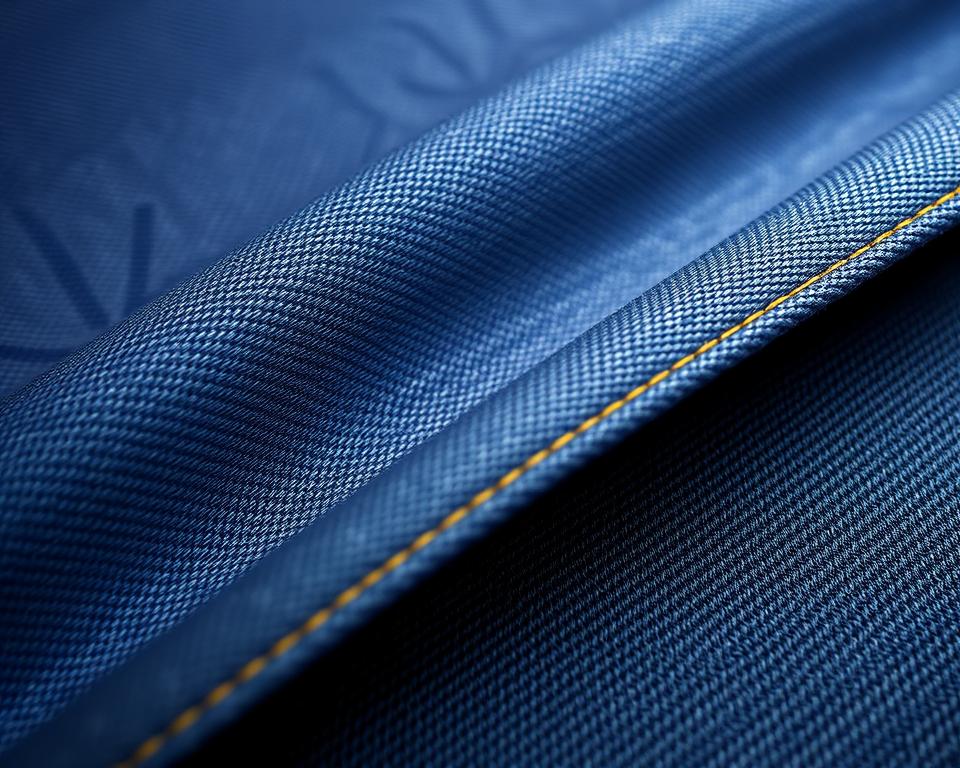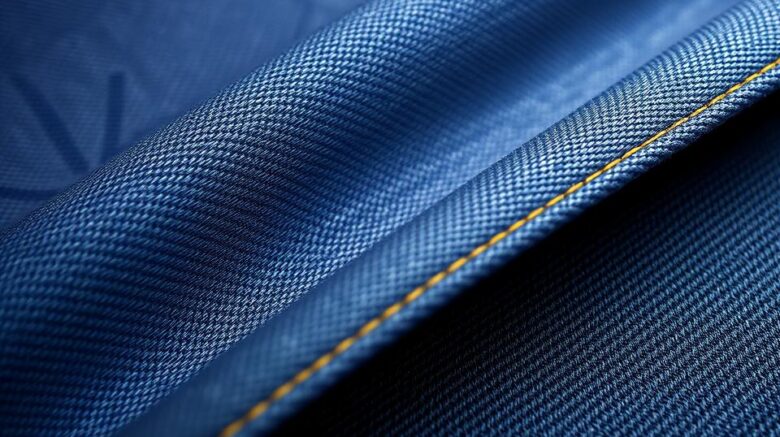A Comprehensive Handbook to Premium denim Selvedge Fabric
Ever pondered why certain jeans feel like they’re made to last the ages? It’s all about the elements and artistry. Consider the growing movement of superior selvedge. This goes beyond common fabric—it exemplifies superiority and tradition.
Nowadays, increasingly more individuals are opting for these classic materials for their sturdiness and iconic selvedge denim fabric allure. Whether you’re a home sewing sewist or a denim aficionado, there’s a unique quality about working with high-quality natural fiber and yarn. It isn’t solely concerned with constructing pants; it’s about fashioning a narrative.
Within Core Fabrics, we’ve assembled a selection of 14.25oz certified organic cotton and stretch options. These fabrics are ideal for all from raw jeans to high-fashion jacket designs. Eager to discover the world of top-tier fabrics? Let’s jump right in.
Defining Denim Selvedge Fabric?
What is it that makes certain jeans set themselves apart with their unique, finished without extra steps borders? The key resides in the selvedge denim, a high-quality material known for its robustness and old-school charm. In contrast to conventional textiles, such material is crafted using traditional methods that have stood the test of time.
The Definition of Selvedge Denim
Selvedge denim is created with retro shuttle looms, which yield slender widths of about 30-35 inches. The looms interlace the fabric in a method that delivers self-finished seams, often marked by a distinctive red line. This method confirms the textile is firmly crafted and extremely robust.
Current looms, on the other hand, yield expansive textile but fall short of the equivalent of skill. Minor flaws in selvedge, like leg twists or uneven textures, are celebrated as part of its charm. This philosophy, often referred to as “the beauty of imperfection”, exalts the aesthetic of organic flaws.
Production of Selvedge Denim
The creation of selvedge denim entails a meticulous process. Traditional shuttle looms weave the horizontal threads alternately, creating a thick and robust material. This method contrasts with modern looms, which focus on speed and efficiency over quality.
Labels such as Karson Denim uphold time-honored Japanese weaving techniques from the 90s. They purposefully add flaws to maintain the true character of the fabric. All products is assessed on a four-point system, ensuring it fulfills the top criteria of superiority.
| Characteristic | Selvedge Denim | Contemporary Denim |
|---|---|---|
| Measure | 30-35 inches | 60+ inches |
| Construction Technique | Classic Shuttle Loom | Contemporary Loom |
| Surface | Non-uniform, Raw | Uniform |
| Strength | Superior | Average |
“The beauty of selvedge lies in its imperfections—every imperfection narrates a tale artistry and heritage.”
The Background of Selvedge Denim
From humble beginnings to worldwide renown, the narrative of these fabrics is rich and moving. Initially designed as rugged attire in the 17th-century France transformed into a mark of classic elegance and excellence.
Beginnings in Craftsmanship
The roots of this material dates back to Nîmes, France, where it was known as “serge de Nîmes.” Originally designed for laborers, it was made from hardwearing cotton and yarn. Its resilience rendered it beloved among workers during the era of the Gold Rush.
During the twentieth century, it had evolved into a staple for trousers. The ending of the Cone Mills White Oak plant became a pivotal moment. This shift enabled Japanese artisans to restore classic fabric-making practices.

Modern Developments in Denim
After World War II, Japan developed a deep appreciation for retro American culture. Skilled workers repaired old looms to create authentic reproductions. This commitment to artistry guaranteed the continuance of selvedge as a unique product.
In modern times, innovations from Italy and Turkey have launched environmentally conscious mixtures and elastic variants. These modernizations have enhanced the appeal of this classic material. At Core Fabrics, we procure internationally, from Montréal to Asia, to deliver to you the best excellence.
“Selvedge’s story is a tribute to the enduring value of excellence and heritage.”
Why Choose Selvedge Denim?
Why does selvedge denim stand out in the realm of premium textiles? Its unique qualities and unmatched durability have made it beloved among lovers and stylists alike. Be it that you are sewing trousers or a sharp jacket, this textile delivers a fusion of classic methods and modern appeal.
Unique Qualities of Selvedge Fabric
Selvedge denim is celebrated for its dense construction, which enhances durability and fade potential. Differing from regular textiles, rainbow selvedge denim is crafted using time-honored shuttle looms, resulting in a denser and extra robust fabric. This process ensures that every item possesses a singular finish and personality.
Key features include:
- Textured, firm raw denim offers a contrast to laundered, relaxed stretch options.
- The sanforization process ensures predictable sizing, while untreated fabrics provide a shrink-to-fit adventure.
- Weight options range from 9.5oz Eco Finish to 14.25oz Organic, catering to diverse applications.
Durability and Longevity
One of the most remarkable aspects of selvedge denim is its long life. The tighter weave not only increases durability but also allows for characteristic wear patterns over time. This makes it a treasured choice for those looking for enduring style.
Key points to consider:
- Mid-weight fabrics from 12oz to 14oz work well for tailored jackets and evolving jeans.
- For classic jean longevity, the 14.25oz True Indigo is a top recommendation.
- Sustainable variants such as recycled cotton combined with indigo blends enhance eco-friendliness.
Core Fabrics offers an assortment of products tailored for every requirement. Spanning from raw finishes to sanforized treatments, each selection is designed for superior quality and value.
Comparing Selvedge and Wide Denim
In the creation of durable and stylish garments, the selection of textile matters significantly. Among the prevalent selections are selvedge and wide denim, both offering different features. Comprehending their variances guides the ideal material for your endeavor.
Contrasting Weave Techniques
Selvedge denim is crafted with traditional shuttle looms, yielding limited spans of 30-35 inches. This striped selvedge denim fabric method generates firm borders, often featuring a signature red line. Wide denim, on the other hand, uses modern projectile looms, producing spans of 60+ inches.
Traditional shuttle looms operate at approximately 3 meters per minute, while projectile looms can produce up to 30 meters per minute. This difference in speed impacts both the cost and the texture of the outcome.
Advantages and Disadvantages
Selvedge denim is renowned for its high-end construction and robustness. Its slender dimension suits it well for projects where visible hems or patches are desired. However, it can be more expensive, typically around $23 per meter.
Wide denim is budget-friendly, priced around $8 per half-meter. Its broader span reduces waste, making it suitable for big-scale works like upholstery. However, it lacks the signature finished border of selvedge.
| Characteristic | Selvedge Denim | Wide Denim |
|---|---|---|
| Width | 30-35 inches | 60+ inches |
| Method | Traditional Shuttle | Projectile Loom |
| Rate | 3 meters per minute | 30m/min |
| Cost | $23 per meter | $8 per half-meter |
When precise, structured edges are required—as in Grainline Thayer jackets—selvedge wins out. Conversely, wide denim is ideal for extensive projects due to its efficiency. Evaluate your project specifications to choose wisely.
Maximizing Your Selvedge Denim
Working with premium materials can elevate your sewing projects to the next level. Whether you’re crafting trousers, jackets, or skirts, grasping fabric quantities, proper sewing methods, and maintenance guarantees a polished result. Let’s explore how to make the most of this classic fabric.
Material Requirements for Jeans and Jackets
Determining the proper yardage is key to a successful project. For men’s jeans, you’ll need about 3-3.3 yards, accounting for potential defects and shrinkage. Trucker jackets typically require 3.3 yards, while a skirt often needs 2 yards.
Creative pattern placement can help manage imperfections in the material. Instead of cutting around defects, consider integrating them into your design for a unique look.
| Garment | Yardage Needed |
|---|---|
| Jeans for Men | 3–3.3 yards |
| Work Jacket | 3.3 yards |
| Skirt Item | 2 yards |
Sewing Techniques and Maintenance
Employing proper equipment and methods leads to an impeccable finish. Select #70 to 110 needles and machine attachments made for robust textiles. For contrast stitching, Gütermann rPET thread is a reliable choice.
Here are some additional tips:
- Use a tailor’s clapper for sharp creases without shine.
- Core Fabrics provides denim kits with topstitch thread, rivets, and 9mm buttons for that expert touch.
- For structured edges, like those in jackets, selvedge is the preferred choice.
Proper care extends the life of your creations. Wash sparingly and air dry to maintain the material’s integrity. Adhering to these practices will sustain your creations for years.
As a Final Point
Working with high-end textiles is not solely about longevity; it’s about infusing character. Selvedge denim exemplifies this principle, fusing craftsman allure with robust strength. Whether you’re sewing jeans or a structured jacket, this material tells a story with every stitch.
At Core Fabrics, we make it easy to explore your creativity. Our swatch service lets you touch and test the fabric before deciding. Plus, enjoy free shipping on orders over $150 USD across North America.
Future trends in cotton textiles include sustainable blends and retro washes. They open fresh avenues for merging sustainability with chic style.
Prepared to immerse yourself in superior fabrics? Begin your journey now and appreciate the merit of intentional crafting. Your future project might just be that lasting masterpiece.
